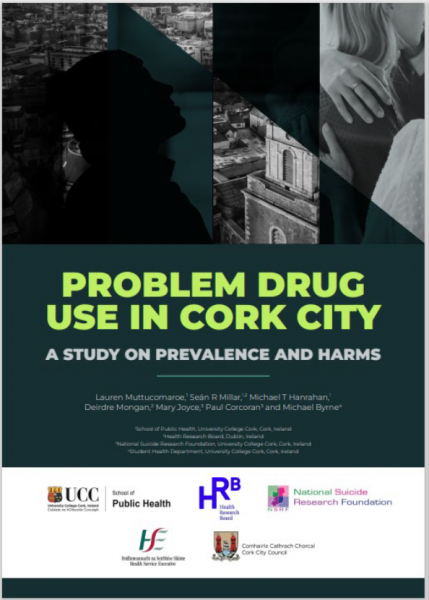Millar, Seán  ORCID: https://orcid.org/0000-0003-4453-8446
(2025)
New report on problem drug use in Cork city published.
Drugnet Ireland,
Issue 91, Spring 2025,
pp. 13-14.
ORCID: https://orcid.org/0000-0003-4453-8446
(2025)
New report on problem drug use in Cork city published.
Drugnet Ireland,
Issue 91, Spring 2025,
pp. 13-14.
| Preview | Title | Contact |
|---|---|---|
|
PDF (Drugnet Ireland 91)
1MB |
Problem drug use (PDU) is defined as recurrent drug use that is causing harm to an individual, or is placing them at a high probability or risk of suffering harm.1 Substances associated with PDU include opioids, cocaine (powder and crack), amphetamines, benzodiazepines, Z-drugs, and gabapentinoids. PDU can lead to many harms for populations and individuals. Such harms include increased criminal activity, drug-related litter, increased risk of infectious diseases passed on from shared syringes and needles, substance use disorders, overdoses, and death.
To date, studies on PDU in Ireland have largely been conducted at a national level or have concentrated on Dublin city, as a majority of PDU has historically taken place within inner city Dublin. However, research suggests that PDU is also occurring in Cork city.2 In 2024, the Health Service Executive (HSE) Cork and Kerry, as well as Cork City Council, contracted the School of Public Health, University College Cork (UCC) to conduct a study on PDU in Cork city. Specifically, the objectives of this research were to provide estimates on the prevalence of PDU; number of syringes exchanged; numbers in treatment; non-fatal overdose cases; and self-harm related to PDU and drug-related deaths in Cork city using the most recent available data and to compare trends over time. The main findings from the published report3 are discussed below.
A four-source capture-recapture analysis estimated that there were 859 (95% confidence interval (CI): 774–1,079) problematic opioid users in Cork city in 2022, which equates to a prevalence rate of 5.59 (95% CI: 5.04–7.02) opioid users per 1,000 population. In 2022, almost one-third of opioid users in Cork city were unknown to services. Between 2019 and 2022 the prevalence of opioid use remained relatively stable, with a majority of users being male and aged between 35 and 64 years. However, the needle exchange programme in Cork city has shown a general increase in the number of syringes exchanged since 2019, with an average of 6,685 syringes being provided each month from pharmacy-based sites in 2023. Data from household surveys demonstrate an increase in the use of cocaine (including crack) and amphetamines, with these increases being noticeably pronounced among young adults. The main problem drug for cases entering treatment in Cork city for PDU has shifted; since 2019, trends indicate a gradual reduction in the number of cases entering treatment for opioids, with an increase in the number of cases accessing treatment services for cocaine use.
For the years 2019–2023, benzodiazepines were the main drug implicated in non-fatal overdose cases in Cork city, followed by opioids, with an average of one opioid overdose occurring each week. Between 2018 and 2021 there was a total of 487 self-harm presentations related to PDU by Cork city residents; benzodiazepines were the main drug implicated in self-harm presentations (63.2%), followed by opioids (30.6%), gabapentinoids (11.9%) and cocaine (9.0%). During this period, there was a total of 140 poisoning deaths due to PDU recorded, with an average of 35 deaths each year. Opioids were the main drug implicated in poisoning deaths (75.7%), followed by benzodiazepines (59.3%), gabapentinoids (27.9%) and cocaine (14.3%).
The authors note that the study shows that PDU is taking place in Cork city, with a number of associated harms. Although Cork city has a variety of harm reduction services that deal with education, assessment, treatment and post-treatment support, the authors suggest that the disconnect between problem drug users and these programmes may benefit from additional services. The authors also recommend ongoing research on PDU in Cork city for effective service planning and to allow policy-makers to evaluate the impact of strategies aimed at reducing drug-related harms.
1 European Monitoring Centre for Drugs and Drug Addiction (2013) PDU (problem drug use) revision summary. Luxembourg: Publications Office of the European Union. Available from: https://www.drugsandalcohol.ie/27693/1/att_218205_EN_PDU%20revision.pdf
2 Hanrahan MT, Millar SR, Phillips KP, Reed TE, Mongan D and Perry IJ (2022) Problematic opioid use in Ireland, 2015–2019. Dublin: Health Research Board. Available from: https://www.drugsandalcohol.ie/35856/
3 Muttucomaroe L, Millar SR, Hanrahan MT, et al. (2025) Problem Drug Use in Cork City: A study on prevalence and harms. Cork: University College Cork. Available from: https://www.drugsandalcohol.ie/42736
A Substance use and dependence > Prevalence > Substance use behaviour
A Substance use and dependence > Substance related societal (social) problems / harms
B Substances > Substances in general
B Substances > Cocaine
B Substances > Opioids (opiates)
B Substances > New (novel) psychoactive substances > Benzodiazepines
B Substances > New (novel) psychoactive substances > Other novel substances > Gabapentinoids GABA (Pregabalin / Gabapentin)
B Substances > New (novel) psychoactive substances > Other novel substances > Zopiclone, eszopiclone, zaleplon and zolpidem
G Health and disease > Substance use disorder (addiction) > Drug use disorder
VA Geographic area > Europe > Ireland > Cork
Repository Staff Only: item control page
